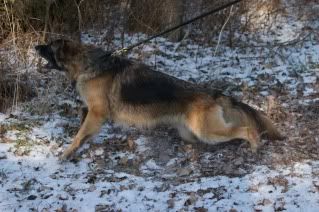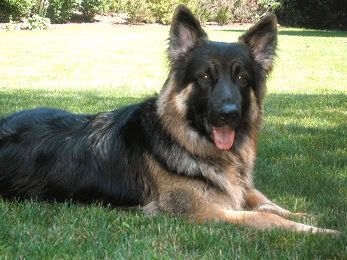 Re: Body Language
[Re: Judy Troiano ]
#189656 - 04/10/2008 11:07 AM Re: Body Language
[Re: Judy Troiano ]
#189656 - 04/10/2008 11:07 AM |
Webboard User
  
Reg: 08-16-2007
Posts: 2365
Loc: Toronto, Ontario, Canada
 Offline Offline |
|
perhaps not helpful, but i find it depends on the dog. some dogs are really obvious and are the sort of perfect, textbook 'friendly' or 'not friendly' dogs. what i usually go by is the attitude that comes off the dog - and i don't know how to explain to look for it - it's like if you're walking, and someone comes towards you, and you can feel their anger, b/c it just rolls off of them. i think dogs do the same. it's a bit different for me than catching my own dog, but i think a lot of dogs make their intent clear in that indefininable (for me) way.
....that probably isn't helpful at all.
edited to add: and brenda aloof's book is great! i really am glad i got it.
another edit: i think some dogs just project intent. and intensity, if that makes sense. luc and teagan could do the same thing, but teagan's going to have a lot more behind it than luc, and that comes across. she's stronger in what she projects out - and yes, you can pick up on little body language twitches, but it also is just an attitude that she projects. my brother said - it's not that he can point to a behaviour or posture, but teagan very clearly to him has a strong sense of self. it's just how she is, what comes out of her. again, i don't know if that helps, but i think you can pick up on that stuff, though i know i'm being a bit wishy-washy in the description.
Teagan!
 |
 Top Top
|
 Re: Body Language
[Re: Judy Troiano ]
#189657 - 04/10/2008 11:21 AM Re: Body Language
[Re: Judy Troiano ]
#189657 - 04/10/2008 11:21 AM |
Moderator

   
Reg: 01-25-2003
Posts: 5983
Loc: Idaho
 Offline Offline |
|
Judy,
A loose dog coming up to Fetz and I during a walk is rare, just due to where I live. I live in a real "law and order" type area, and people do not take lawlessness and rule breaking very lightly here.
In that situation, I do watch the dog approaching and observe it's body posture closely, and I'll just yell at it to scare it off. If it continues to advance on us and I have *any* concerns about it becoming a bad encounter, well, that's when I draw my Glock.
One bad encounter with a dog attack by someone's loose dog can hurt the temperament of a good dog. I'm not about to let that happen. A loose aggressive dog is a public safety hazard and should be dealt with promptly.
And reading aggression coming from a dog approaching you is pretty obvious, most of the time.
Fetz protects me from people - I protect him from attacks by loose redneck dogs. Fair is fair.
|
 Top Top
|
 Re: Body Language
[Re: Judy Troiano ]
#189658 - 04/10/2008 11:27 AM Re: Body Language
[Re: Judy Troiano ]
#189658 - 04/10/2008 11:27 AM |
Webboard User

   
Reg: 10-30-2005
Posts: 4531
Loc: South Dakota, USA
 Offline Offline |
|
Just some things I notice with my dogs....
I will just list them but not by each individual dog:
breathing changes (may be faster, may be slower or they may hold it for a few seconds)
forward, ears up, lips pursed forward, low growl, high pitch bark, tail up and curled, "stalking stance",
sitting and leaning away but throwing rapid glances at at me then launching at the person making him uncomfortable (this is Max only, and I know it is more of a shy/fear reaction)
These are just a few, there are more obvious ones and more subtle ones but those are what they do most if allowed.
I do not really correct the dog for this, but rather just give a "uh uh" or "stop" command and they listen and it is more towards other dogs that try and approach and not each other.
I do have fights here though....not often but it happens, due to my not paying attention. It might be over a ball, or a cinnamon roll on the counter, or when I am petting one and another wants some, but it does happen. I do not have them out together very often either though.
Until The Tale of the Lioness is told, the Story will Always Glorfy the Hunter |
 Top Top
|
 Re: Body Language
[Re: Carol Boche ]
#189686 - 04/10/2008 01:21 PM Re: Body Language
[Re: Carol Boche ]
#189686 - 04/10/2008 01:21 PM |
Webboard User

  
Reg: 08-02-2007
Posts: 1078
Loc: Southern Oregon
 Offline Offline |
|
I agree that you learn to read your dog as an individual first, then considering the average warning signs.
The most common warning sign people miss is a tensing of the body, most evident in the tail and the legs. The legs will look "stiff" and though the tail may have a wag to it, it will be slower, more deliberate, almost halting.
Ear possition depends on why the dog is becoming aggressive. Ears forward shows confidence, dominance, or prey response. Ears to the side shows uncertainty, defensive aggression. Ears back is nervous/scared/fear aggression. Ears that flick forward and back and side and forward etc the dog is very unsure, nervous, distracted(sensory overload type thing) where they are being overstimulated, it is fear based. If you get specific fear based is defensive and defensive is fear based but for me a fear biter, the aggression is the last straw, it is very stressed, really just wants to get away, is backed into a corner etc. With Defensive it is more forward, the dog is not trying to run it is defending itself with aggression first. If that makes any sense at all.
This is just in my observation of course 
Breathing is cue as well, and not only if the eyes are wide or narrow but if the pupil is dilated or contracted. Either larger than normal (dilated) or smaller than normal (contracted). These are things that are more subtle and take time to notice and take note of. Dilated pupils are often a sign of stress, which is the most common thing you will notice in dogs about to become aggressive as stress includes fear and defensive behavior. I consider all aggression to include at least some stress for the animal.
It all goes for knowing your individual dog, and I've just listed the more subtle things that people tend to miss. There are a lot of others out there that people are quick to note such as snarling, growling, hackling, lunging etc.
|
 Top Top
|
 Re: Body Language
[Re: Jennifer Marshal ]
#189692 - 04/10/2008 02:39 PM Re: Body Language
[Re: Jennifer Marshal ]
#189692 - 04/10/2008 02:39 PM |
Webboard User
 
Reg: 09-22-2005
Posts: 979
Loc: New Jersey
 Offline Offline |
|
Thanks so much everybody for your anwers!! 
There are some things I would not have known to look for, especially something like the tail wagging in a halting type motion. Contracted pupils  . I'm a long way from spotting that signal.
Ear possition depends on why the dog is becoming aggressive. Ears forward shows confidence, dominance, or prey response. Ears to the side shows uncertainty, defensive aggression. Ears back is nervous/scared/fear aggression. Ears that flick forward and back and side and forward etc the dog is very unsure, nervous, distracted(sensory overload type thing) where they are being overstimulated, it is fear based.
Thanks Jenn! The position of the ears was a little confusing to me before. That explanation was immensely helpful  .
|
 Top Top
|
When purchasing any product from Leerburg Enterprises, Inc. it is understood
that any and all products sold by Leerburg Enterprises, Inc. are sold in Dunn
County Wisconsin, USA. Any and all legal action taken against Leerburg Enterprises,
Inc. concerning the purchase or use of these products must take place in Dunn
County, Wisconsin. If customers do not agree with this policy they should not
purchase Leerburg Ent. Inc. products.
Dog Training is never without risk of injury. Do not use any of the products
sold by Leerburg Enterprises, Inc. without consulting a local professional.
The training methods shown in the Leerburg Ent. Inc. DVD’s are meant
to be used with a local instructor or trainer. Leerburg Enterprises, Inc. cannot
be held responsible for accidents or injuries to humans and/or animals.
Copyright 2010 Leerburg® Enterprises, Inc. All rights reserved. All photos and content on leerburg.com are part of a registered copyright owned by Leerburg Enterprise, Inc.
By accessing any information within Leerburg.com, you agree to abide by the
Leerburg.com Privacy Policy and Terms of Use.



 Top
Top




 Top
Top




 Top
Top



 Top
Top


 Top
Top
 Previous Topic
Previous Topic Index
Index Next Topic
Next Topic














 . I'm a long way from spotting that signal.
. I'm a long way from spotting that signal.



.jpg)